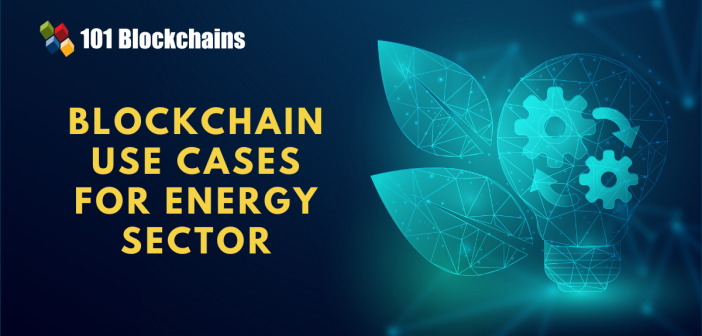Learn how blockchain truly works, master key definitions, and uncover what makes smart contracts so "smart." Dive into the fundamentals, gain valuable insights, and start your blockchain journey today!

Analyst Corner
101 Blockchains
on May 21, 2021
Blockchain in the Renewable Energy Sector
Due to the growing concern over global climate change, renewable energy usage and adoption have become the need of the hour.
The use of conventional energy resources has been increasing exponentially, becoming a major barrier to the mass adoption of renewable energy.
The effects of excessive usage of fossil fuels and other conventional energy resources can be seen in global climatic conditions such as hurricanes, floods, glacier melting, forest fires, and a lot more. Lately, such disastrous effects have intensified more than ever and the need for a sustainable alternative has become more prominent. The excessive use of fossil fuel can also be seen in other not so commonly observed areas such as the loss of sea ice, rising sea levels, heatwaves, and deterioration of the ozone layer.
Moreover, there are several parameters involved such as infrastructure, accessibility, understand the need and purpose, and initial cost that hinder the adoption of renewable energy.
For instance, people will not be interested in buying electric vehicles unless they understand the core purpose behind them. Even if some people understand, they will face several problems such as no charging stations in their region or even no vendors. Buying a petrol-based car and finding a petrol pump nearby will never be a barrier.
One thing that should be considered here is, even if charging stations are installed and even if vendors are there, it solves the problem of a particular region. In order for renewable energy to be mainstream, several other factors come into play.
Build your identity as a certified blockchain expert with 101 Blockchains’ Blockchain Certifications designed to provide enhanced career prospects.
The way forward…
As with every other sector, the renewable energy sector requires advanced technological integrations and implementations to combat the challenges.
More prominently, the integration of Blockchain in the renewable energy sector or the use of blockchain in energy sector seems to be the most appropriate implementation for this sector.
Blockchain, a distributed ledger technology operating with a consensus mechanism eradicates the need for a third party and established a peer-to-peer network.
Blockchain offers an immutable ledger created by using the highest forms of cryptography and stored in a decentralized environment. Therefore, blockchain eradicates the need for a third party to maintain user data and allows for a better, transparent system.
Different components of Blockchain such as nodes, smart contracts, and tokens can be used in different ways to solve particular use case problems which allows a variety of Blockchain Use Cases For Energy to be feasible.
Blockchain Use Cases For Energy
Let us see the various factors holding back the mass adoption of renewable energy consumption and how Blockchain implementation becomes a suitable answer:
1. Microgrids
By creating a peer-to-peer network, Blockchain in the energy sector accommodates the development of microgrids owned by small to medium businesses.
The creation of microgrids truly decentralizes energy production and takes away the dependency on a central authority. If the main grid fails then the microgrids can still accommodate the energy needs in their respective regions. If any microgrid fails, the main grid can provide energy to the region being supported by that microgrid. However, there are several challenges faced in such a setup such as the lack of market visibility, central authority, and political influence.
If a business can be sure of the constant demand for energy, it will be more interested in developing a renewable energy production house such as windmills, to create constant supply. Being on the Blockchain, the whole lifecycle of the energy produced can be tracked which removes the possibility of central authority dominance.
The most important use of Blockchain in the energy sector here will be to connect the microgrids with the main grids to manage the demand and supply in an unbiased manner.
If one microgrid falls short of energy supply due to high demand, a smart contract can be triggered to provide additional energy to the microgrid from another microgrid that has an extra supply. After such a scenario the same smart contract also provides that supply back at a later point in time when the first microgrid stabilizes.
Therefore, Blockchain-based smart contracts can be used to minimalize human intervention and automatically execute certain conditions.
2. Smart meters
A smart meter is a device used for monitoring the consumption of energy and deciding the energy rates. In a Blockchain ecosystem, these smart contracts provide data directly to the blockchain ledger and not to any third party. Therefore, the possibility of manipulation of data by a third party becomes obsolete.
Further, these smart meters can be controlled by smart contracts. Smart contracts can be developed to automatically calculate the energy rates and provide transparency in terms of charges. These smart contracts can also regulate the energy consumption of individual households.
Curious to understand the complete smart contract development lifecycle? Enroll in Smart Contracts Development Course Now!
3. Lack of market visibility
The market for renewable energy sources is fragmented. Whether the objective is to connect the producer with the seller or the seller with the consumer, connecting the two entities is not easy in a fragmented market. Therefore, use of blockchain in the energy sector as a marketplace becomes a global platform where buyers, sellers, transporters, storage providers, and all other entities can interact.
Another perspective in market visibility is the lack of interaction between a skilled professional and businesses.
In most cases, energy producers are unable to meet the best storage facility or the best transport facility. This is due to the absence of a marketplace where all the entities can meet and interact. Traditionally, if a renewable energy producer wants to provide services in a different geographic location, they require a storage facility, transport, and seller in that location. This process is done over the phone or email which makes it lethargic, slow, and inefficient.
The reason why this interaction has not been digitalized properly is that Internet-based communications are not believed to be trustworthy and there is always a possibility of fraud. However, the advent of Blockchain in the energy sector has made this feasible.
Blockchain Technology is getting popular with its new and latest trends. Here are the top Blockchain Trends for 2021.
4. Centralization
One of the prominent use cases of Blockchain in energy is decentralization. The current energy segment is governed by central authorities or large corporations. The rates for energy are decided by the authorities and they control the production as well as supply of the energy. This leads to a significant dependence on the seller.
Blockchain in the energy sector allows it to be customer-centric. Every interaction related to energy consumption, payments, charges, and production will be recorded on the immutable ledger of Blockchain. This induces a sense of responsibility among the entities as all of them will be answerable for their actions. Further, the process the be streamlined using smart contracts.
With pre-written code executing pre-defined functionalities and existing in a definite state on Blockchain’s ledger, the different processes such as calculation of charges, taxes, and regulating the energy consumption can be done in defined and transparent standards.
5. Lack of transparency
Many businesses around the world claim that they have leveraged the latest technologies to reach cleaner fossil fuel production and usage. For instance, the burning of coal is believed to be made more cleaner and efficient. Therefore, other businesses or the normal population become reluctant towards the usage of alternative resources such as wind or solar energy due to the misbelief that conventional resources can be used in a sustainable way.
The biggest challenge here is to bring reality into the picture rather than just assumptions. Even if the use of fossil fuels becomes cleaner, it can never be as clean as the current climate conditions require. Even if there is a minimal greenhouse effect of using fossil fuels, the fact is that these fossil fuels are being used at an extremely large scale and the small numbers add up to millions.
Therefore, the need of the hour is a system where we can convince the world about the grave effects of fossil fuel consumption and the value brought by renewable energy sources. Therefore, one of the major barriers in the adoption of renewable energy sources is the lack of transparency as to how much value they carry.
Even if we use an Internet-based platform to track individual usage and show the effects of that usage on the climate, it becomes a non-trustworthy source. Many people think of it as a trick by climate activists.
This is where Blockchain in the energy sector adds value. Building a Blockchain-based marketplace where the consumption and its effects can be monitored in real-time.
The two most prominent benefits from having such a marketplace are a. Transparency of industry usage and b. Individual awareness.
Blockchain in the energy sector can be used to track each individual activity and provide real-time authentic data of how these activities are affecting the climate. For instance, if a person can see that his daily car usage is contributing 0.01% to the reduced air quality index in his area, he will be tempted to reduce individual usage.
More importantly, if the carbon footprint of the industries is visible to the masses along with credibility, it will force industries to adopt sustainable energy resources in order to get customer interest.
Blockchain is perfect for boosting efficiency for your company. If you want to implement blockchain technology in energy sector, check out our guide on blockchain implementation strategy now!
Other Blockchain use cases for energy:
1. Tokenization of Carbon Credits
A carbon credit is equivalent to one metric ton of carbon dioxide and represents the allowed greenhouse gases the companies can emit. These are the credits given by governments under cap-and-exchange programs set up to restrict the quantity of carbon dioxide produced by the organizations. In other words, carbon credits are used to define how much harm can a company do to the earth’s atmosphere.
Tokenization of Carbon credits on Blockchain helps in the monetization of illiquid credits to motivate people. As industry consumption becomes transparent, the need for additional carbon credits will be there. Industries can buy these carbon credits from individuals in the form of tokens. These individuals will be reducing their allowed carbon footprint consumption with the purpose of selling these credits to the industries.
Want to learn the fundamentals of tokenization? Enroll Now: Tokenization Fundamentals Course
2. Crowd Funding
Setting up the infrastructure for renewable energy production requires a considerable initial investment which is one of the biggest barriers. Even if the business owners are interested, they are unable to get the investment due to limited access to potential investors.
On the other hand, Investors are unable to find credible projects.
Here, a blockchain-based ecosystem connects the investors and the businesses. Using a token-based approach, the investors can directly provide liquidity to the businesses and monitor the use of those tokens in real-time. Furthermore, the transfer of tokens on a Blockchain-based application will be fast, reliable, and cost low transaction fees.
Start learning Blockchain with World’s first Blockchain Skill Paths with quality resources tailored by industry experts Now!
Conclusion
Renewable energy needs to be adopted at the individual level for it to become mainstream and implementation of Blockchain use cases for energy are required to achieve such an adoption. Rather than just big corporations, every individual can create their source of renewable energy and get exposed to an unbiased marketplace.
For instance, installing solar panels at home. While the initial investment for such an infrastructure is considerably high which is why most people prefer continuing with their existing energy sources. However, if there was a way to monetize personal production, it would act as an incentive model for people to go that extra mile and invest in renewable energy infrastructure.
Therefore, use of blockchain in the energy sector is the perfect example of a truly decentralized world where even the production and consumption of energy is controlled and governed by the people.
*Disclaimer: The article should not be taken as, and is not intended to provide any investment advice. Claims made in this article do not constitute investment advice and should not be taken as such. 101 Blockchains shall not be responsible for any loss sustained by any person who relies on this article. Do your own research!






